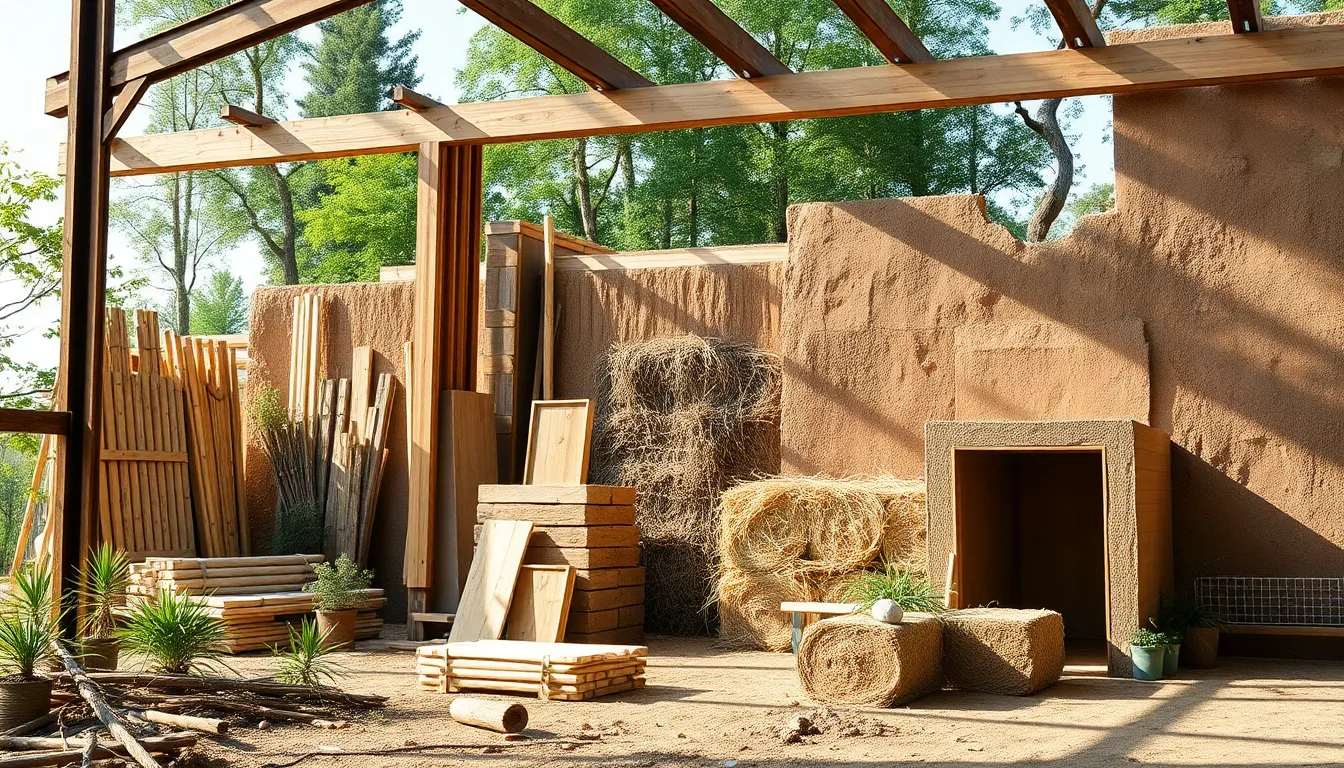Table of Contents
ToggleIn a world where the concrete jungle seems to grow taller by the day, eco-friendly building materials are here to save the planet—one brick at a time. Imagine constructing a home that not only looks good but also feels good to the Earth. It’s like giving Mother Nature a warm hug while sipping your organic green tea.
These sustainable materials are the superheroes of the construction industry, battling climate change and reducing waste with style. From bamboo beams that could outlast your last relationship to recycled steel that’s tougher than your morning coffee, eco-friendly options are more than just a trend; they’re a lifestyle choice. So, why not build a future that’s as green as your favorite smoothie? Let’s dive into the world of eco-friendly building materials and discover how they can transform spaces while keeping the planet smiling.
Overview of Eco-Friendly Building Materials
Eco-friendly building materials play a crucial role in sustainable construction practices. They help reduce environmental impact, promote health, and support resource conservation.
Definition and Importance
Eco-friendly building materials refer to substances derived from renewable resources or those produced with minimal environmental harm. Utilizing these materials mitigates the effects of climate change and minimizes waste, making them essential in modern construction. They contribute to healthier indoor environments, often containing fewer toxic chemicals. Their adoption supports a circular economy, emphasizing sustainability and conservation. By prioritizing eco-friendly options, the construction industry aligns itself with global sustainability goals.
Benefits of Using Eco-Friendly Materials
Using eco-friendly materials offers numerous advantages. These options often lead to improved energy efficiency, reducing utility costs for homeowners. They protect natural resources by decreasing reliance on non-renewable materials. Many eco-friendly options enhance indoor air quality, benefiting occupants’ health. Choosing sustainable materials can also increase property value, making homes more attractive to buyers. A growing preference for green buildings fosters a positive community image, encouraging local investment and support.
Types of Eco-Friendly Building Materials
Eco-friendly building materials play a crucial role in promoting sustainable construction practices. A diverse range of options exist that cater to various aesthetic and structural needs.
Bamboo
Bamboo stands out as a highly sustainable material due to its rapid growth. It can reach maturity in three to five years, making it an excellent renewable resource. Builders appreciate bamboo for its strength, which often rivals traditional hardwoods. Additionally, bamboo enhances indoor air quality as it absorbs carbon dioxide during growth. Its versatility allows for diverse applications, from flooring to structural beams, appealing to both eco-conscious and design-minded individuals.
Recycled Steel
Recycled steel significantly reduces environmental impact by conserving resources and minimizing waste. Utilizing post-consumer metal contributes to energy savings, as producing new steel requires substantial energy. This material boasts remarkable durability and resistance, ensuring longevity in various constructions. Architects often incorporate recycled steel for aesthetic purposes, offering a modern, industrial look. Transitioning to this material supports the circular economy, promoting sustainable practices in industrial sectors.
Straw Bale
Straw bale serves as an effective insulation material, offering excellent thermal performance. This natural resource maintains a low carbon footprint, showcasing its sustainability credentials. Building with straw bales allows for unique architectural designs, including curved and organic shapes. Many builders opt for straw bale construction due to its affordability and availability in agricultural regions. Its use fosters a connection to local farming practices while enhancing energy efficiency in homes.
Rammed Earth
Rammed earth provides an ancient yet modern approach to eco-friendly building. Composed of natural raw materials, this method results in sturdy and energy-efficient walls. Products made from rammed earth offer thermal mass, which helps regulate indoor temperatures. Builders often appreciate its aesthetic appeal, as it creates a unique, earthy texture and color. Implementing rammed earth techniques also aligns with sustainable practices, reinforcing commitment to resource conservation and reducing ecological footprints.
Sustainable Sourcing and Production
Sustainable sourcing and production methods play a crucial role in the eco-friendly building materials sector. Efficient practices significantly lower the environmental impact while promoting resource conservation.
Local Sourcing
Local sourcing strengthens communities and reduces transportation emissions. Materials sourced within the region cut down on fuel consumption, enhancing sustainability. Options include locally sourced timber or regional stone, which support local economies and preserve unique architectural styles. Builders benefit from shorter delivery times, minimizing logistical complexities. Sourcing materials close to the construction site fosters a sustainable cycle from production to installation.
Reduced Carbon Footprint
Choosing eco-friendly materials leads to a reduced carbon footprint. Many sustainable products use fewer resources and generate less waste throughout their life cycles. For instance, materials like recycled steel and reclaimed wood minimize resource extraction and manufacturing emissions. Implementing efficient production processes further decreases energy use and greenhouse gas emissions. By prioritizing these materials, the construction industry takes significant strides toward climate resilience while meeting sustainability goals.
Environmental Impact
Eco-friendly building materials play a crucial role in minimizing environmental harm and promoting sustainability in construction practices. Their benefits extend to energy efficiency and waste reduction.
Energy Efficiency
Energy efficiency significantly increases when utilizing eco-friendly materials. Structures built with sustainable options often require less energy for heating and cooling due to improved insulation properties. For example, materials like straw bale provide excellent thermal performance. This lowers energy consumption, directly impacting utility costs and emissions. Additionally, features like energy-efficient windows complement sustainable building materials, further enhancing overall efficiency. Ultimately, using these materials contributes to a greener, more sustainable future.
Waste Reduction
Waste reduction is another vital aspect of eco-friendly building materials. Many sustainable options, such as recycled steel and reclaimed wood, prevent valuable resources from ending up in landfills. Efficient manufacturing processes often lead to less waste generation during production. Furthermore, local sourcing reduces transportation waste and supports regional economies. Implementing strategies like deconstruction rather than demolition promotes material reuse and recycling, minimizing unnecessary waste. By prioritizing these practices, the construction industry can significantly lessen its environmental footprint.
Conclusion
Embracing eco-friendly building materials is essential for a sustainable future in construction. These materials not only enhance the beauty and functionality of structures but also play a vital role in reducing environmental impact. By choosing options like bamboo and recycled steel, builders and homeowners contribute to energy efficiency and waste reduction.
The shift toward sustainable practices fosters healthier living environments and strengthens local economies. As the construction industry evolves, prioritizing eco-friendly materials becomes a powerful statement about commitment to the planet. Adopting these practices paves the way for a greener and more resilient future for generations to come.





